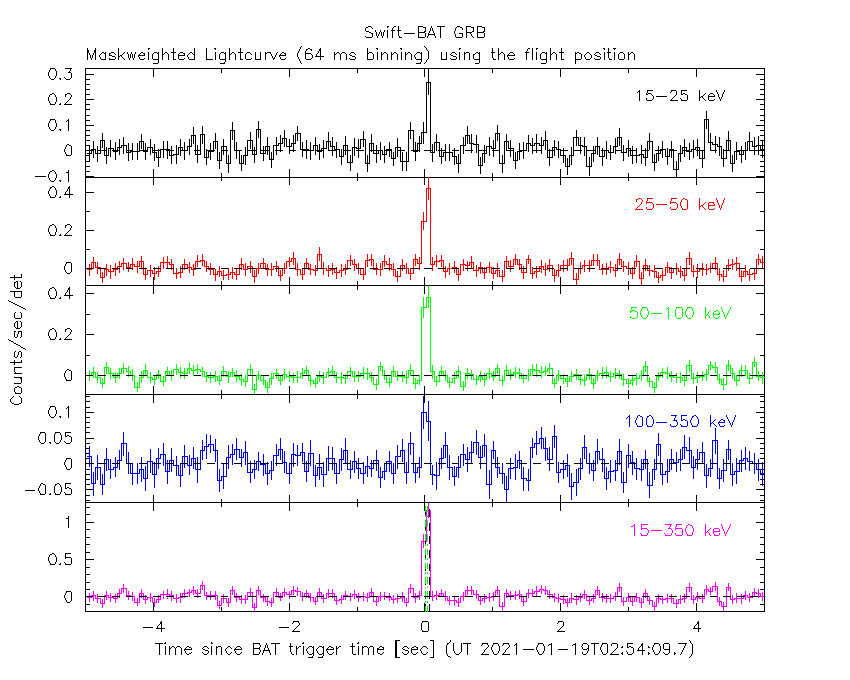
M.J. Moss (GWU) for the Swift team
At 02:54:09 UT, the Swift Burst Alert Telescope (BAT) triggered and located a short burst which would be either an unknown Soft Gamma Repeater or GRB 210119A (trigger=1017711) (Moss et al. GCN Circ. 29323). Due to an observing constraint, Swift did not slew immediately to the burst. At the time of the trigger, the initial BAT position was 43° from the Sun (1.2 hours West) and 89° from the 34%-illuminated Moon. Table 1 contains the best reported positions from Swift.
Tiurina et al. (GCN Circ. 29325) reported the position from MASTER for the optical afterglow of this GRB. Table 2 is a summary of GCN Circulars about this GRB from observatories other than Swift.
Standard analysis products for this burst are available at https://gcn.gsfc.nasa.gov/swift_gnd_ana.html.
As reported by Ukwatta et al. (GCN Circ. 29332),
the BAT ground-calculated position is RA, Dec = 282.822, -61.767 deg which is RA(J2000) = 1
The mask-weighted light curve (Figure 1) shows a single spike with a FRED-like shape, rising sharply at T+0 s and decaying to background by T+0.1 s.
The time-averaged spectrum from T+0.00 to T+0.08 s is best fit by a simple power-law model.
The power law index of the time-averaged spectrum is 1.41 ± 0.22.
The fluence in the 15-150 keV band is 7.1 ± 0.9 x 1
The results of the batgrbproduct analysis are available at https://gcn.gsfc.nasa.gov/notices_s/1017711/BA/.
XRT refined results are not available.
UVOT results are not available.

Figure 1. The BAT
mask-weighted light curve in the four individual and total
energy bands. The units are counts
| RA (J2000) | Dec (J2000) | Error | Note | Reference |
|---|---|---|---|---|
| 1 |
-61°45'59.7" | 1.5' | BAT-refined | Ukwatta et al. GCN Circ. 29332 |
| Band | Authors | GCN Circ. | Subject | Observatory | Notes |
|---|---|---|---|---|---|
| Optical | Lipunov et al. | 29324 | Fermi GRB 210119A: Global MASTER-Net observations report |
MASTER | |
| Optical | Tiurina et al. | 29325 | Short Fermi GRB 210119A or new SGR Swift J1851.2-6148: Possible MASTER Short OT detection |
MASTER | possible detection |
| Gamma-ray | Fermi | 29322 | Fermi GBM Final Real-time Localization | Fermi GBM | |
| Gamma-ray | Mangan et al. | 29328 | Fermi GBM observation | Fermi GBM | Fluence=3.432±0.397x1 (5 |
| Gamma-ray | 29329 | Insight-HXMT/HE detection | Insight-HXMT |
January 21, 2021